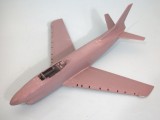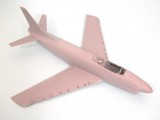Special Hobby 1/48 F-86K Sabre
The North American F 86D Sabre was a development of the basic F-86 Sabre that had so little commonality with previous sub-types that it was originally ordered as the YF-95. The designation was changed to F-86D in 1950, following the outbreak of the Korean War, when it was felt the Congress was more amenable to spending money on new types of existing successful aircraft. In fact, outside of the wings and landing gear, virtually everything else about the “Dog Sabre” was completely different from any other aircraft designated “F-86.”
The aircraft was developed as a transonic jet all weather interceptor, utilizing a large AN/APG 36 all weather radar in a nose radome above a drastically-redesigned jet intake, with an armament of 48 2.75-inch Mighty Mouse Folding Fin Aerial Rocket (FFAR), a rocket based on the German R4M rockets of WWII, designed to bring down a Soviet bomber with one shot. It was the first all-weather interceptor developed for a one-man crew with only a single jet powerplant. With afterburner, it was capable of supersonic flight in a shallower dive than that required to “make a boom” by the other members of the F-86 family.
Design commenced in March 1949 and the unarmed YF-95 prototype, 50-577, first flew on 22 December 1949, piloted by North American test pilot George Welch.
The fuselage was wider and the airframe length was increased to 40 ft 4 in, with a clamshell canopy, enlarged tail surfaces. Later models of the F 86D received an uprated J 47 GE 33 engine rated at 5,550 lb thrust. A total of 2,504 D models were built, equipping dozens of Air Defense Command squadrons in the mid-50s, and Air National Guard squadrons in the late-50s/early 60s.
The NATO air forces showed interest in the aircraft, but the USAF did not want to release the Hughes fire control system, so a variant with armament changed to the MG 4 fire control system using APG 37 radar and four 20 mm M24A1 cannon with 132 rounds per gun was proposed and accepted. The fuselage was lengthened to accommodate the guns, but otherwise, the airframe was the same as the F 86D. The type saw quite a bit of service with NATO nations in the late 1950s up to the mid-1960s.
The first 120 F-86Ks were produced by North American, equipped with the standard early slatted wing used on the F-86A and F-86E. These were later retrofitted with the later wings. 221 F-86Ks produced by Fiat had the F-86F-40 wing with extended wingtips, the “6-3" leading edge, and leading edge slats. 62 F 86Ks were built by Fiat for France in 1956-57and were assigned to EC 1/13 Artois, EC 2/13 and EC 3/13 Alpes Squadrons. All F-86Ks used by the French, Italian, West German, Dutch and Norwegian air forces were supplied under the MDAP assistance program, with the Italian air force being the largest operator with 240 F-86Ks. Following their retirement from NATO, ex-Italian F-86Ks were later sold to the Venezuelan and Turkish air forces where they served alongside US F-86Ds; six ex-Venezuelan F-86Ks were later sold to the Honduran Air Force.
This F-86K by Special Hobby is the first full kit of the type released in 1/48. Must-Have Models released a limited run conversion with a fuselage to be used with the Monogram/Revell F-86D; this would only be correct for the first 120 F-86Ks operated by the Italian Air Force.
Fortunately, the Special Hobby kit has a correctly-swept wing with a 35-degree sweep on the leading edge, unlike the Monogram kit which got the 35-degree sweep on the main spar, resulting in a wing sweep of about 38 degrees.
There are two boxings of the kit. 48126 has decals for French and West German aircraft, while 48123 has decals for Dutch, Italian and Norwegian F-86Ks. The West German markings include one in green-grey camouflage and one in natural metal. All the others are for unpainted airplanes.
Special Hobby messed up the main gear well on the initial release, and has corrected it with a resin gear well on subsequent kits. If you get the early kit (as I did), you cannot fit the plastic main gear well inside the wings. You can only cut off the outer gear wells in the wing and then reshape the central well to fit inside the fuselage.
The Special Hobby decals are very thin and will fold up like a cheap suit on the first opportunity if used without modification. A coat of Micro-Scale liquid decal film will solve the problem, but you then have to trim the decals very closely to avoid excess film for the unpainted aircraft.
Regarding assembly, it's a Special Hobby limited-run kit, with all that means. This is not one of their kits that goes together “pretty well,” it goes together “pretty badly.” A modeler needs to test fit everything three times before gluing once, and there will be filler on all seams with lots of sanding and subsequent re-scribing of surface detail. Since all the versions in both kits are unpainted aluminum except one, this will mean sanding down through ever-finer grit, with polishing before rescribing, to get a surface that looks good under metallic paint. That said, if you take you time and do the extra work, the result looks good.
I started with the fuselage and built up the cockpit and the intake trunking. I painted the cockpit dark grey. The seat is accurate and the photo-etch seat belts give it a good look. There is none of the equipment associated with raising and lowering the canopy included, so I glued the canopy in the down position; the good news is that by doing this, the kit-supplied cockpit detail is sufficient once completed. I filled the radome and the nose area ahead of the cockpit and above the intake trunking with fish weights to insure nose-fitting and attached the jet exhaust before closing up the fuselage. There were considerable gaps along the centerline seam that required Mr. Surfacer 500 to fix.
Rather than describe all the angst I went through discovering the complete lack of fit of the plastic main gear well, I will just say that if you get the early release that doesn't have the resin replacement part, you can mail the end of the kit box to Special Hobby and they will send you the resin part free. If you don't want to wait, you can forget the gear well interior for the wings, and trim the central well to fit inside the fuselage. This looks acceptable once the model is assembled.
The leading edge slats have separate actuating arms, and need to be assembled with care so everything is properly aligned with the wing when attached.
Attaching the wing sub-assembly to the fuselage requires considerable test-fitting to get the two properly together and aligned, and you will use Mr. Surfacer on the join lines fore and aft on the lower fuselage, and the join of the upper wings to the fuselage.
Special Hobby provides all the very small vortex generators that are on the tail area as separate photo-etch. After losing the first three to the carpet monster, I decided I could live without them. If you are convinced you need them, I suggest you get some .010 x .020 Evergreen strips and cut them and use them for the fins, since you can replace all the ones you will lose.
Once all was together, I decided to use the model as my first excursion into using the new Vallejo acrylic metallic colors. This was actually my second choice. I had previously painted the model in camouflage with the intention of doing a Bundesluftwaffe F-86K; however, that was where I found out about the propensity of the decals to fold up. Since there are no other replacement decals for that marking, I stripped the model to bare plastic and started over again.
The Vallejo paints are great for those who don't want to use Alclad due to the smell factor. Since it's acrylic paint, there is no likelihood of SWMBO coming in the painting shop waving a rolling pin, complaining about smell, or telling you to take everything outside and close the windows behind you.
It is necessary to apply the gloss black primer coat if you are going to do a multi-hue metal finish and need to mask over the paint. If you do that, there is no problem. After painting the radome black and the anti-glare panel dark green, and the exhaust area with Tamiya titanium and masking all that, I applied the primer coat. This dries to the touch in 30 minutes or less. I then applied the overall coat of Aluminum. The metallic paints are airbrush-ready and do not require thinning. While the metallic paint also dries to the touch quickly, I let it cure overnight before masking on it.
I masked around the wing central areas and used Dull Aluminum for that area. I masked other panels and used Duiraluminum for the area around the gun barrels and White Aluminum for the speed brakes and other small panels. While the tonal differences aren't that great in the accompanying photos, they are apparent in person.
Overall, I like this paint much better than Alclad. There is no likelihood of the paint eating the model, you don't need to wear an oxygen mask while applying it, or a crash helmet for protection from critics. The paint is about as expensive as Alclad, and has a similar final look. And it cleans up easily with water. I am a definite fan.
I used the kit decals, after giving them a coat of Micro Liquid Decal Film, to do an F-86K of EC 1/13, circa 1960 according to the kit instructions. The decals went on without trouble on the Vallejo paint surface, under a coat of Micro-Sol.
I unmasked the other paint areas and the canopy, then attached the landing gear and the drop tanks.
Other than the “own goals” scored in my personal quest of discovery to find out how I was going to deal with the Special Hobby design philosophy of “Fit? Fit?! We don't need no stinking fit, stinking Yankee!” the result looks better than I expected while working on it. If you pay attention to fitting parts before gluing them, and take care in getting the final surface nice and smooth, you can get a very nice result with the kit, and have the last version of Sabre you couldn't find elsewhere in your collection. Recommended for those with good experience with limited run kits.
























Tom, congradulations on bending it to your will!
Amazing that we are finally seeing one, even after all this time.
What Special Hobby turns out is tempting, but obviously not for the faint of heart.
Fine work! Go have a beer, or two.
Nice Sabre dog K
That's a really nice job Tom, but I have to tell you that Monogram kit was a peach to build even with the 38 degree wing.
Nice looking Sabre Dog. Thanks for the tips on the Vallejo metallics - I may give them a try soon.